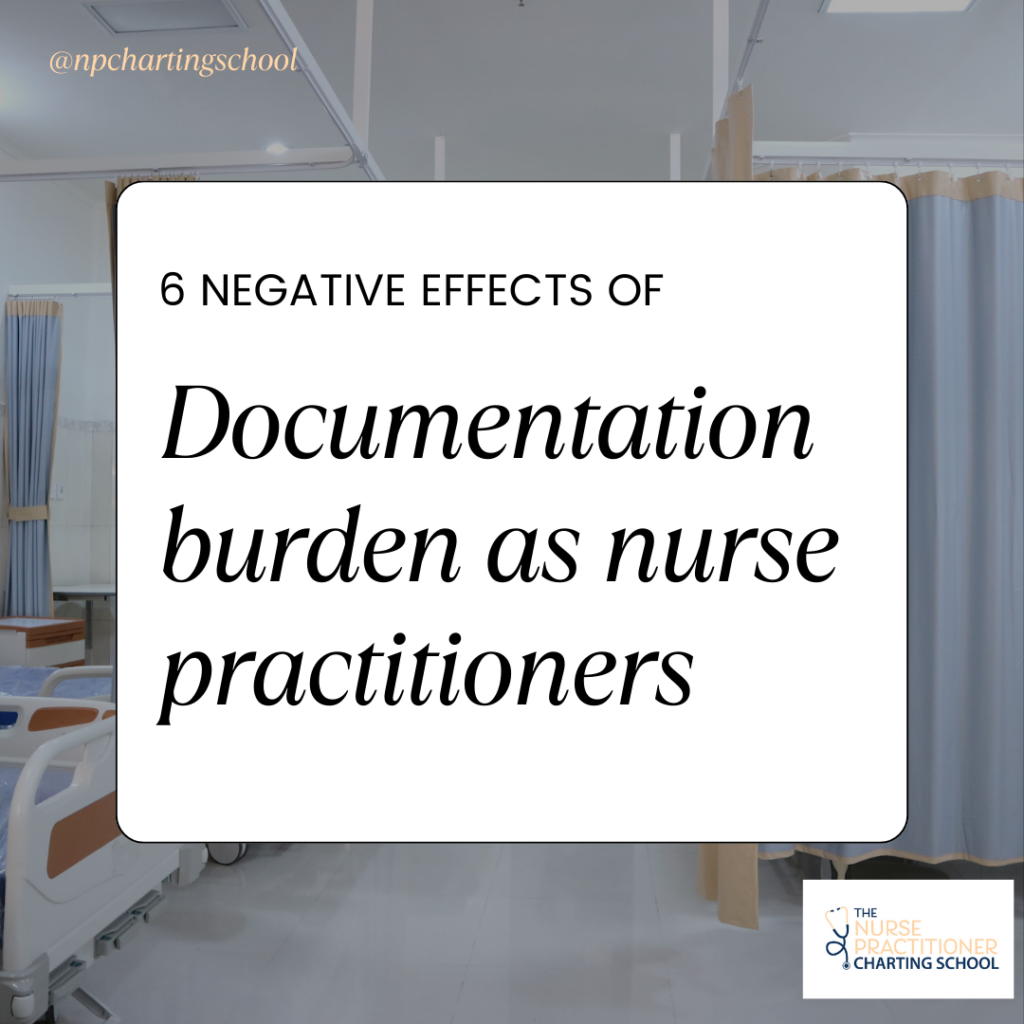Nurse practitioners spend more time documenting than direct patient care time. A study by Budd (2023) looked at Burnout Related to Electronic Health Record Use in Primary Care. This study showed that healthcare providers spend 49.2% of their time on EHR and only 27% of their time in direct patient care. This same study shows that 63% of providers report that charting disrupts their work-life balance. This documentation burden as nurse practitioner is ultimately causing nurse practitioner burnout.
What is documentation burden as nurse practitioners
Several organizations are trying to improve the documentation burden as nurse practitioners, such as American Medical Informatics Association (AMIA) with their work in the 25 x 5 Task Force. The goal is to reduce documentation burden by 25% in the next 5 years.
But the burden is already apparent as nurse practitioners.
As nurse practitioners, our work day is filled with pouring so much time and energy into charting. We are constantly staring at a computer screen and switching from task to task.
Not only do nurse practitioners assess, diagnose, and treat patients, we also have to document the findings. Then add on the medication refills, reviewing past medical documentation, analyzing diagnostic data, and the never-ending patient messages. This creates a documentation burden that is never ending.
This documentation burden as nurse practitioners can ultimately lead to multiple unfavorable outcomes. While many of these results are similar and relate to one another, it is important to discuss each result separately. In this article, we will take a look at these negative effects of documentation burden as a nurse practitioner.
Negative effects of documentation burden
Lack of work-life balance.
As The Nurse Practitioner Charting Coach, I have worked with so many nurse practitioners who struggle with charting. So many APRNs stay late at the office or bring their charts home, just trying to catch up. The documentation burden as nurse practitioners significantly disrupts their work-life balance. Nurse practitioners spend so much time and energy devoted to their jobs and it leaves very little time for their families. The documentation burden nurse practitioners face cause this work-life imbalance.
Mom guilt as nurse practitioners
Many nurse practitioners feel pulled in many different directions. Those APRNs that are also parents experience an increase in stress and overwhelm. So many nurse practitioner moms experience mom guilt. When nurse practitioners are faced with the documentation burden, they end up working long, hard hours.
This causes a depletion of their time and energy. When nurse practitioner moms have nothing left to give, it creates a sense of mom guilt. This documentation burden creates a strain on parents and is a significant risk factor for causing nurse practitioner mom guilt.
Decline in personal health
The documentation burden as nurse practitioners can create a decline in personal health. Many nurse practitioners are spending so much time charting that they forgo taking care of themselves. Not to mention the increase in stress, lack of energy for exercise, decrease in time to prepare healthy meals, etc.
The documentation burden can cause a decrease in mental, emotional, and physical health. As nurse practitioners, we know the importance of taking care of our health. But the amount of time and energy we spend at work makes that very challenging. The documentation burden takes a toll on our personal health.
Strain on personal relationships
When nurse practitioners are constantly overwhelmed by their work, they have little time and energy to invest in personal relationships. When APRNs are constantly consumed by thoughts of charting and feel burdened by a charting backlog, this adds stress and overwhelm. This ultimately negatively impacts our personal relationships with spouses, family, and friends. These close relationships are often strained because of the documentation burden as nurse practitioners.
Decreased job satisfaction
The documentation burden as nurse practitioners can cause a decrease in job satisfaction. When nurse practitioners spend so much time at work (or charting at home) they begin to resent their employer. Nurse practitioners who are spending 60+ hours working start to hate their job. And why wouldn’t they? Salaried jobs only pay for 40 hours of work per week.
That means the additional time is not only unpaid but also negatively impacts Nurse practitioner’s personal lives and relationships. The documentation burden can cause nurse practitioners to leave their current role, in search of a better opportunity. This creates a high turnover rate which ultimately negatively impacts the patient’s care.
Leads to nurse practitioner burnout
All of the negative effects of documentation burden as nurse practitioners can compile and create nurse practitioner burnout. The nurse practitioners who are spending more time charting and less time with their friends, families, or even themselves can end up experiencing burnout.
Nurse practitioner burnout occurs when an APRN is completely depleted. They may feel detached from their work, their patients, their loved ones, and even themselves. The documentation burden is the top cause of nurse practitioner burnout.
Documentation resources for nurse practitioners
The multiple negative effects of documentation burden as nurse practitioners takes a toll on APRNs. So many NPs are ready to leave the workforce due to the documentation burden.
As The Nurse Practitioner Charting Coach, I help overwhelmed nurse practitioners to improve their charting so they can create a better work-life balance and ultimately STOP charting at home.
The STOP Charting at Home Membership provides nurse practitioners with the support, education, and community they need to STOP charting at home.
The annual membership includes group coaching calls, monthly workshops on charting tips, a private community of equally burned-out NPs, and an all access pass to resources/courses created by The Nurse Practitioner Charting School!
Learn more by viewing: The STOP Charting at Home Membership.
References
**Don’t check my APA format, I’ve tried to block that from my mind post school.
Budd, J. (2023). Burnout related to electronic health record use in primary care. Journal of Primary Care & Community Health. https://www.ncbi.nlm.nih.gov/pmc/articles/PMC10134123/

Erica D the NP is a family nurse practitioner and The Nurse Practitioner Charting Coach. Erica helps nurse practitioners STOP charting at home! Erica created The Nurse Practitioner Charting School to be the one stop for all documentation resources created specifically for nurse practitioners. Learn more at www.npchartingschool.com
Follow on Facebook: The Nurse Practitioner Charting SchoolAnd on Instagram: @npchartingschool
Free training: 4 charting tips to help nurse practitioners get their time back! Sign up here!



